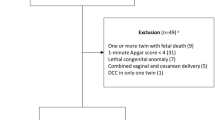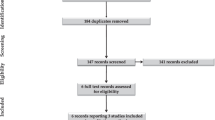Abstract
Objective
To evaluate the effect and safety of different umbilical cord clamping (UCC) timing.
Study design
This was a randomized trial of 720 term mothers/infants from the Tianjin Central Hospital of Obstetrics and Gynecology delivered from December 2014 to May 2015 and randomized to immediate cord clamping (ICC) within 15 s, delayed cord clamping (DCC) by 30, 60, 90, 120, 150, or 180 s, or when the umbilical cord pulsation ceased.
Results
24 h after delivery, the mean infant hematocrit levels were 56.5, 57.3, 58.8, 59.7, 59.5, 59.7, 60.3, and 61.0% in the ICC, 30, 60, 90, 120, 150, and 180-second DCC, and no pulsation groups, respectively (P = 0.021, 0.001, 0.003, 0.001, <0.001, and <0.001, respectively; standard deviations ranging 5.4–8.7%). There was no significant difference between the 30-second DCC and ICC groups. No significant differences were found in other neonatal and maternal outcomes among these groups.
Conclusion
For term infants, DCC increases the hematocrit values, without apparent harmful effects on the infants and their mothers.
This is a preview of subscription content, access via your institution
Access options
Subscribe to this journal
Receive 12 print issues and online access
$259.00 per year
only $21.58 per issue
Buy this article
- Purchase on Springer Link
- Instant access to full article PDF
Prices may be subject to local taxes which are calculated during checkout


Similar content being viewed by others
References
Andersson O, Hellstrom-Westas L, Andersson D, Clausen J, Domellof M. Effects of delayed compared with early umbilical cord clamping on maternal postpartum hemorrhage and cord blood gas sampling: a randomized trial. Acta Obstet Gynecol Scand 2013;92:567–74.
Arca G, Botet F, Palacio M, Carbonell-Estrany X. Timing of umbilical cord clamping: new thoughts on an old discussion. J Matern Fetal Neonatal Med 2010;23:1274–85.
Bayer K. Delayed umbilical cord clamping in the 21st century: indications for practice. Adv Neonatal Care 2016;16:68–73.
Brocato B, Holliday N, Whitehurst RM Jr., Lewis D, Varner S. delayed cord clamping in preterm neonates: a review of benefits and risks. Obstet Gynecol Surv 2016;71:39–42.
Hooper SB, Binder-Heschl C, Polglase GR, Gill AW, Kluckow M, Wallace EM, et al. The timing of umbilical cord clamping at birth: physiological considerations. Matern Health Neonatol Perinatol 2016;2:4.
Nesheli HM, Esmailzadeh S, Haghshenas M, Bijani A, Moghaddams TG. Effect of late vs early clamping of the umbilical cord (on haemoglobin level) in full-term neonates. J Pak Med Assoc 2014;64:1303–05.
Salari Z, Rezapour M, Khalili N. Late umbilical cord clamping, neonatal hematocrit and Apgar scores: a randomized controlled trial. J Neonatal Perinatal Med 2014;7:287–91.
Farrar D, Tuffnell D, Airey R, Duley L. Care during the third stage of labour: a postal survey of UK midwives and obstetricians. BMC Pregnancy Childbirth 2010;10:23.
Hutton EK, Stoll K, Taha N. An observational study of umbilical cord clamping practices of maternity care providers in a tertiary care center. Birth 2013;40:39–45.
Leslie MS. Perspectives on implementing delayed cord clamping. Nurs Womens Health 2015;19:164–76.
Pisacane A. Neonatal prevention of iron deficiency. BMJ 1996;312:136–37.
Yao AC, Moinian M, Lind J. Distribution of blood between infant and placenta after birth. Lancet 1969;2:871–73.
Farrar D, Airey R, Law GR, Tuffnell D, Cattle B, Duley L. Measuring placental transfusion for term births: weighing babies with cord intact. BJOG 2011;118:70–75.
Oliveira Fde C, Assis KF, Martins MC, Prado MR, Ribeiro AQ, Sant’Ana LF, et al. Timing of clamping and factors associated with iron stores in full-term newborns. Rev Saude Publica 2014;48:10–18.
Raju TN. Timing of umbilical cord clamping after birth for optimizing placental transfusion. Curr Opin Pediatr 2013;25:180–87.
Committee on Obstetric P. Committee Opinion No. 684: Delayed Umbilical Cord Clamping After Birth. Obstet Gynecol 2017;129:e5–e10.
Ladipo OA. Management of third stage of labour, with particular reference to reduction of feto-maternal transfusion. Br Med J 1972;1:721–23.
Chaparro CM, Neufeld LM, Tena Alavez G, Eguia-Liz Cedillo R, Dewey KG. Effect of timing of umbilical cord clamping on iron status in Mexican infants: a randomised controlled trial. Lancet 2006;367:1997–2004.
van Rheenen PF, Brabin BJ. A practical approach to timing cord clamping in resource poor settings. BMJ 2006;333:954–58.
Katheria AC, Lakshminrusimha S, Rabe H, McAdams R, Mercer JS. Placental transfusion: a review. J Perinatol 2017;37:105–11.
Oski FA, Naiman JL. Normal blood values in the newborn period. In: Oski FA, Naiman JL, editors. Hematological Problems in the Newborn. 3rd ed. Philadelphia: WB: Saunders; 1982.
World Health Organization. WHO Recommendations for the Prevention and Treatment of Postpartum Hemorrhage. Geneva: World Health Organization; 2012.
Andersson O, Hellstrom-Westas L, Andersson D, Domellof M. Effect of delayed versus early umbilical cord clamping on neonatal outcomes and iron status at 4 months: a randomised controlled trial. BMJ 2011;343:d7157.
Hutton EK, Hassan ES. Late vs early clamping of the umbilical cord in full-term neonates: systematic review and meta-analysis of controlled trials. JAMA 2007;297:1241–52.
Ranjit T, Nesargi S, Rao PN, Sahoo JP, Ashok C, Chandrakala BS, et al. Effect of early versus delayed cord clamping on hematological status of preterm infants at 6 wk of age. Indian J Pediatr 2015;82:29–34.
Hutchon DJ. Why do obstetricians and midwives still rush to clamp the cord? BMJ 2010;341:c5447.
Murakami H, Yamamoto N, Shibata T, Takeda K, Ichinose Y, Ohe Y, et al. A single-arm confirmatory study of amrubicin therapy in patients with refractory small-cell lung cancer: Japan Clinical Oncology Group Study (JCOG0901). Lung Cancer 2014;84:67–72.
Ceriani Cernadas JM, Carroli G, Pellegrini L, Otano L, Ferreira M, Ricci C, et al. The effect of timing of cord clamping on neonatal venous hematocrit values and clinical outcome at term: a randomized, controlled trial. Pediatrics 2006;117:e779–e86.
Fliegner JR, Hibbard BM. Active management of the third stage of labour. Br Med J 1966;2:622–23.
Jahazi A, Kordi M, Mirbehbahani NB, Mazloom SR. The effect of early and late umbilical cord clamping on neonatal hematocrit. J Perinatol 2008;28:523–25.
van Rheenen P, de Moor L, Eschbach S, de Grooth H, Brabin B. Delayed cord clamping and haemoglobin levels in infancy: a randomised controlled trial in term babies. Trop Med Int Health 2007;12:603–16.
Katheria A, Poeltler D, Durham J, Steen J, Rich W, Arnell K, et al. Neonatal resuscitation with an intact cord: a randomized clinical trial. J Pediatr 2016;178:75–80. e73
Katheria A, Rich W, Finer N. Optimizing care of the preterm infant starting in the delivery room. Am J Perinatol 2016;33:297–304.
Acknowledgements
We thank the midwives and obstetricians of the Tianjin Central Hospital of Obstetrics and Gynecology for their cooperation, as well as the parents who, with generosity, gave their consent. We are deeply indebted to Virender Rehan for revising the paper.
Funding
The research was part of the project of System of noninvasive prenatal screening and diagnosis methods for fetomaternal hemorrhage, supported by TianJin Municipal Science and Technology Commission.
Author information
Authors and Affiliations
Corresponding author
Ethics declarations
Conflict of interest
The authors declare that they have no competing interests.
Ethical approval
All procedures performed in studies involving human participants were in accordance with the ethical standards of the institutional and/or national research committee and with the 1964 Helsinki declaration and its later amendments or comparable ethical standards.” (Ethical approval number: 2016KY020).
Additional information
Xu Chen and Xing Li are First authors.
Rights and permissions
About this article
Cite this article
Chen, X., Li, X., Chang, Y. et al. Effect and safety of timing of cord clamping on neonatal hematocrit values and clinical outcomes in term infants: A randomized controlled trial. J Perinatol 38, 251–257 (2018). https://doi.org/10.1038/s41372-017-0001-y
Received:
Accepted:
Published:
Issue Date:
DOI: https://doi.org/10.1038/s41372-017-0001-y
This article is cited by
-
Umbilical cord milking and delayed cord clamping for the prevention of neonatal hypoglycaemia: a systematic review and meta-analysis
BMC Pregnancy and Childbirth (2024)
-
Effects of timing of umbilical cord clamping for mother and newborn: a narrative review
Archives of Gynecology and Obstetrics (2023)
-
Effects of delayed cord clamping at different time intervals in late preterm and term neonates: a randomized controlled trial
European Journal of Pediatrics (2023)
-
What does the evidence tell us? Revisiting optimal cord management at the time of birth
European Journal of Pediatrics (2022)
-
Effects of delayed cord clamping on neonatal jaundice, phototherapy and early hematological status in term cesarean section
Italian Journal of Pediatrics (2021)



